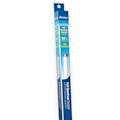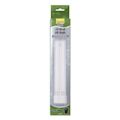Aquarium Replacement Bulbs
Get It Today
Aquarium Replacement Bulbs
Lighting is an essential part of any aquarium habitat—most aquarium-dwelling pets can benefit from various aquarium light setups. There are a few selections to choose from:
- Incandescent bulbs
- T-5 and T-8 fluorescent bulbs
- Metal Halide bulbs
- LED bulbs
- Power compact bulbs
- UV bulbs
FAQs About Aquarium Lights
8 to 12 hours is usually the maximum amount of time you should keep aquarium lamps lit. It’s good to turn them off at night to mimic your pet’s habitat in the wild—living under constant light may be a stressor for your pet.
If you’re housing reptiles, it’s often a good idea to give them a warm spot and a cool spot. That way, they can take a break from the heat if needed. If you have plants, make sure all of them have access to the rays.
It’s important to do your research and find out exactly what size, color and intensity your plants or pets need before purchase. Then follow the directions on the packaging carefully—you should always use extreme caution when installing anything fueled by electricity around water.
Yes. LED lights are actually an excellent choice for plant life due to their ability to mimic natural light cycles. Just make sure to research how much light your plant needs so you can get the correct spectrum.
Aquarium Replacement Bulbs
Aquarium UV Bulbs
Aquarium Blue Bulbs
Aquarium Light Fixtures
T-5 & T-8 Aquarium Fluorescent Bulbs
Aquarium Lighting & Hoods
48 Inch Aquarium Light
UVB Bulbs for Reptiles
Aquarium Light Enhancements
Aquarium LED Bubbles
Brightest Aquarium Light
Aquarium UV Clarifiers
Affordable Aquarium Lights
Aquarium Lighting for Deep Tanks
Aquarium Tank Products
Aquarium Water Care
Aquarium Equipment
Aquarium Care Accessories
Aquarium Filter Pumps
Aquarium Plants & Accessories
Aqueon Aquarium Replacement Bulbs
Zoo Med Aquarium Replacement Bulbs
Lifegard Aquatics Aquarium Replacement Bulbs
Aqueon Aquarium Light Fixtures
Fluval Aquarium Light Fixtures
Imagitarium Aquarium Light Fixtures
Lifegard Aquatics Aquarium Light Fixtures
Coralife Aquarium Light Fixtures
Hydor Aquarium Light Fixtures
GloFish Aquarium Light Fixtures
Lifegard Aquatics Aquarium Lighting & Hoods
Imagitarium Aquarium Lighting & Hoods
Coralife Aquarium Lighting & Hoods
Aqueon Aquarium Lighting & Hoods
Hydor Aquarium Lighting & Hoods
AQUAILLUMINATION Aquarium Light Fixtures
GloFish Aquarium Lighting & Hoods
Coralife Aquarium Accessories
Zoo Med Aquarium Lighting & Hoods
Fluval Aquarium Lighting & Hoods
My fish tank LED light broke. Is using an LED flashlight safe for the fish?
My bearded dragons heat lamp just burnt out - I don’t have a replacement and all of the local reptile/pet stores are closed for the night. What do I do to keep him safe until tomorrow when I can get him a new light?
I got a lED fish light for my fish tank and I only got one light for one side so far and where the light is its growing a brown algae really bad and the other side without the light isn't. Do certain lights cause algae. If so, what lights don't and what type of lighting is the best? I have two filters in my tank and it's only one side so I dont think it would be anything else
I have a 20 gallon tank for my bearded dragon and I just need to know how many watts of UVB do I need
Is hydrogen peroxide safe to use on aquarium fish
How to disinfect dry aquarium used soil after six months ?....I can replaced before 6 months for aquarium snail(reason)...It's very high quantity...So I take out from planted aquarium
I have a turtle I got as a hatchling whose shell has started to curve. I’ve read this could be due to too much protein, too weak of uv/uvb lights, or a combination that makes him grow too fast for the shell to keep up. I’m going to the pet supply store to get a new bulb tomorrow and he eats feeder fish as well as a variety (gold fish food he steals, dry meal worms, pellets from two different brands) of dry foods. How can I help him better?
I have recently used medication in my 50 gal freshwater fish tank with one 22 year old comet goldfish in it . the meds cured my fish but must have killed my beneficial Bacteria as now my established tank has been going through another nitrogen cycle. It's been four weeks now the ammonia us back to zero so is nitrite zero BUT my nitrates are now spiked about 80 and the water is cloudy. Did 2 partial water changes over the last 8 days. Will a UV sterilizer help ?? Please advise. Thanks Lina
We are new to having aquariums, we really didn't realize so many things played a factor with the water. We currently have a 10 gallon tank but want to increase to a 29 gallon tank. We currently buy gallons of water but with the 29 gallon tank we really don't want to have to do that. We have well water with a salt filter. My levels from to tap was nitrate 10, nitrite 0, hardness 0, chlorine 0, alk 100, ph 7.. is my tap water safe even with the salt filter.
Hi, I have a marine fish tank with 4 fish, an anemone, and a couple of invertebrates. There's nothing wrong right now but I'm scared that I might have jeopardized the aquarium's safety during a maintenance routine. I was doing some aquascaping when I realized that I forgot to rinse my hand beforehand, which worries me because I had handled clorox wipes (benzyl ammonium chloride) roughly 30 minutes before touching the water. Are my fish going to be ok, and is there anything I can do right now?
I have new aquarium with few gold fish and milky white carp fish. Some skin problems is infecting in all my fishes like skin coming out. And all fishes are showing abnormal behavior. Please help me fr saving my fishes
I want Angel Alvarado to answer this question. What fish can i put in a 3 gallon tank besides shrimp. If I have to get neon tetras please tell me how to change their water. Thanks


